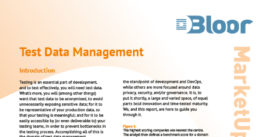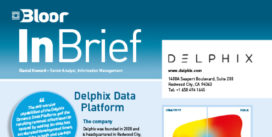Delphix keeps hold of a single, continuously updated copy of each of your production databases that you can provision virtual copies against as required. You can refresh, reset, or rewind your personal copies at any time, and you can also bookmark, branch and share them. Notably, provisioning is incremental, meaning that when your production database is updated, only those updates (and not entire datasets) will be pushed out to your virtual copies during a refresh. Even then, refreshes are strictly on demand: your users are given the freedom to decide if and when they need an update. In addition, multiple databases can be provisioned in a synchronised fashion. This could be used, for example, to facilitate integration testing for applications that use data from multiple sources. What’s more, the platform’s “data time machine” functionality provides a complete record of all production deltas, meaning that at any time you can look back and see exactly what changed, and when, in your production data.
If your data sources contain sensitive data, you will also need to discover and mask it. In Delphix, this functionality is generally applied when you first create a copy of any given production database, creating a masked version of it that desensitised virtual copies can subsequently be provisioned from. That said, it can also be used standalone. Both sensitive data discovery and masking are automated, and a library of masking algorithms is provided. They can be scheduled or run on-demand, apply to both structured and unstructured data, are consistent across all of your data (including data spread across multiple clouds) and come with preconfigured templates tailored to some common use cases, including applications (such as SAP) and regulations (such as GDPR). The platform supports tokenisation, as well as audit and compliance reporting, and if you already have a preferred data masking solution, you can use that instead.
The platform also includes the Data Control Tower, a data governance layer that lies on top of Delphix’s other capabilities, offering a single, central, and enterprise-wide location for controlling the totality of your Delphix deployment. In addition, Delphix provides a distributed data library that sits just under the Data Control Tower, which acts as a data catalogue that provides tagging functionality, versioning, and fine-grained, attributed-based access control, among other things. Together, they provide self-service access to your data, whether through the data library itself, APIs, or the provided CLI (Command Line Interface).
Data protection is available through the Continuous Vault addon, which will continuously synchronise your data with an immutable data vault in near real-time. It is certainly much faster than more traditional backup and restore, or automated recovery, solutions. Another addon, Elastic Data, adds elastic storage, allowing you to leverage cost-efficient object storage in addition to the more expensive (but also more performant) block storage already present. The latter can then be reserved for use as a performance cache. Notably, there are plans to bring this elastic storage capability to other Perforce offerings (such as the Helix Core version control solution), making it a good example of cross pollination between Delphix and the rest of the company’s product suite. Similarly, BlazeMeter can be used to inject synthetic data into your Delphix data sets. Add Perfecto, and you can create an end-to-end, continuous test automation solution, capable of providing high quality, masked, and virtualised data to your test environments, using only Perforce products.









